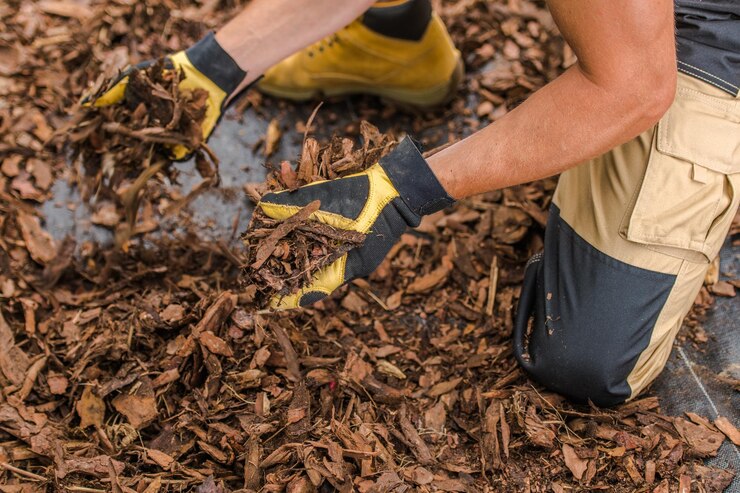When it comes to enhancing your garden’s beauty and health, cedar mulch is one of the top choices for homeowners and landscapers alike. Known for its distinctive scent, long-lasting durability, and ability to repel pests, cedar mulch is not only functional but also adds a natural, rustic charm to your garden. In this article, we’ll explore the many benefits of cedar mulch, how to use it effectively, and why it might be the perfect addition to your landscaping project.
What is Cedar Mulch?
Cedar mulch is a type of organic mulch made from the wood and bark of cedar trees. It comes in several forms, such as:
- Shredded cedar mulch: Fine-textured and ideal for garden beds where smooth coverage is desired.
- Chipped cedar mulch: Larger wood pieces that offer a chunkier, more rugged look.
- Cedar bark mulch: Often used for a more natural appearance, resembling the tree’s outer bark.
The mulch is usually reddish-brown in color, though it can vary depending on the tree species and processing methods. Cedar mulch is known for its durability, pleasant aroma, and natural ability to resist decay, making it an excellent choice for long-lasting garden applications.
Benefits of Cedar Mulch
Cedar mulch offers several advantages for both aesthetics and the health of your garden:
- Aesthetic Appeal: The rich, warm color of cedar mulch enhances the visual appeal of garden beds, pathways, and landscaped areas. Its uniform texture creates a polished, professional look in any garden design.
- Moisture Retention and Soil Insulation: One of the primary benefits of using mulch is its ability to retain moisture in the soil. Cedar mulch acts as a barrier, reducing water evaporation from the soil and keeping roots hydrated for longer periods, especially in hot weather.
- Weed Control: A thick layer of cedar mulch suppresses weed growth by blocking sunlight and preventing weeds from establishing themselves in the soil.
- Natural Insect Repellent: The oils found in cedarwood naturally repel many garden pests, including ants, termites, and moths. This property makes cedarmulch an excellent choice for gardeners looking for a more natural way to protect their plants.
Cedar Mulch vs. Other Types of Mulch
How does cedar mulch compare to other popular mulches like pine, hardwood, or rubber mulch? Here’s a quick comparison:
- Durability: Cedarmulch breaks down more slowly than pine or hardwood mulch, lasting up to two to three years before needing to be replaced.
- Organic Breakdown: Unlike rubber mulch, cedar mulch is organic and will eventually decompose, enriching the soil with organic matter.
- Maintenance: Cedarmulch requires less frequent refreshing compared to softer mulches like pine, but still adds a natural touch that rubber or synthetic mulches can’t match.
Cedar Mulch as a Natural Insect Repellent
One of the standout benefits of cedar mulch is its ability to naturally repel insects. The oils in cedarwood are toxic to many common garden pests, including ants, termites, mosquitoes, and cockroaches. By spreading cedar mulch around your plants, trees, and garden beds, you create a protective barrier that reduces the need for chemical pesticides.
However, cedar mulch is also safe for beneficial insects like bees and butterflies, making it an eco-friendly option for pollinator gardens. It’s also pet-safe, so you won’t have to worry about any harm to your furry friends.
Where and How to Use Cedar Mulch in Your Garden
Cedar mulch is versatile and can be used in various landscaping applications:
- Flower Beds: Cedarmulch is ideal for flower beds as it helps retain moisture and prevents weed growth while enhancing the color of your plants.
- Around Trees and Shrubs: Applying cedar mulch around the base of trees and shrubs protects their roots, helps maintain soil moisture, and provides insulation against temperature extremes.
- Pathways and Walkways: The chunkier varieties of cedar mulch work well for defining garden paths and walkways, offering a natural, rustic look while also preventing soil erosion.
For the best results, spread cedarmulch at a depth of 2-3 inches, ensuring that the mulch isn’t packed tightly against plant stems or tree trunks, as this can lead to moisture retention and rot.
How to Apply Cedar Mulch
Applying cedar mulch is straightforward, but a few key steps will ensure you get the most out of it:
- Prepare the Soil: Remove any existing weeds or old mulch. Loosen the soil with a rake or garden fork to allow water and nutrients to penetrate easily.
- Spread the Mulch: Apply the cedarmulch evenly, aiming for a depth of 2-3 inches. For areas prone to weed growth, you can lay a layer of landscape fabric underneath the mulch for added protection.
- Refresh as Needed: Cedarmulch breaks down slowly, but over time, it may lose some of its color and effectiveness. Refresh your mulch every 1-2 years by adding a new layer or raking it to improve airflow.
Does Cedar Mulch Affect Soil pH?
One common concern among gardeners is whether cedarmulch affects soil acidity. Cedarmulch is slightly acidic, but not enough to significantly alter soil pH in most gardens. However, if you’re growing acid-sensitive plants, such as certain vegetables or flowers, you may want to test your soil’s pH periodically and adjust with lime or other soil amendments as needed.
Cedar Mulch and Weed Control
Cedar mulch provides excellent weed control by creating a thick barrier that prevents weed seeds from receiving the sunlight they need to germinate. For even better results, combine cedarmulch with landscape fabric or weed barriers to create a long-lasting weed-free environment. Mulching regularly helps keep weeds at bay, saving you time on garden maintenance.
Cedar Mulch and Water Conservation
In drought-prone areas, cedarmulch is a valuable asset. By covering the soil, it helps retain moisture, reducing the need for frequent watering. It also protects plants from the drying effects of wind and direct sunlight, helping them thrive in arid conditions. When using cedarmulch, be mindful of your irrigation practices—water the soil beneath the mulch to ensure that plants receive adequate hydration.
Cedar Mulch’s Longevity and Durability
Cedarmulch is known for its excellent longevity and durability, making it a popular choice for landscaping. Here are some key factors that contribute to its long-lasting performance:
1. Natural Resistance to Decay
Cedarwood contains natural oils and compounds like thujaplicins, which give it resistance to rot, decay, and fungal growth. This helps the mulch last longer than other types of organic mulch like pine or hardwood, which decompose more quickly.
2. Pest Repellent Properties
Cedar also has insect-repelling properties, thanks to its natural oils. It deters pests like termites, ants, and moths. This reduces the need for frequent replacement, as pest damage is minimal.
3. Slow Decomposition Rate
Cedarmulch decomposes slowly due to its dense wood structure and chemical composition. It can last for several years before needing to be replenished, unlike other mulches that may need replacing annually.
4. Color Retention
Cedarmulch retains its natural reddish color longer than many other mulches. While it will eventually fade due to sun exposure, it takes longer to turn gray compared to other wood-based mulches.
5. Durability in Various Conditions
Cedarmulch holds up well under different weather conditions. It doesn’t wash away easily in rain, and its structure helps retain moisture, protecting plant roots during dry periods. It’s also resistant to compaction, which means it stays aerated and functional over time.
Lifespan of CedarMulch:
- General Duration: Cedarmulch can last anywhere from 2 to 3 years before needing a significant refresh, depending on the climate, moisture levels, and how thickly it’s applied.
- Regular Maintenance: While the mulch itself remains effective, you may need to rake or fluff it occasionally to keep it looking fresh and to improve air circulation.
Overall, cedarmulch is a durable, low-maintenance option that provides both functional and aesthetic benefits in landscaping.
Conclusion:
Cedar mulch is a top-tier choice for landscaping due to its long-lasting durability and natural resistance to decay, pests, and weathering. With its ability to retain color and resist compaction, it offers both aesthetic and functional benefits over several years. Although it decomposes slowly, minimal maintenance is required to keep it looking fresh, making it a cost-effective and sustainable option for gardens and flower beds.
FAQs about Cedar Mulch
1. How long does cedarmulch last?
Cedarmulch typically lasts 2 to 3 years before needing a refresh. Its slow decomposition rate ensures that it remains effective for an extended period.
2. Does cedarmulch repel insects?
Yes, cedarmulch naturally repels many insects, including termites, ants, and moths, due to the oils present in the wood.
3. Does cedarmulch lose its color?
Over time, cedarmulch will fade, but it retains its reddish hue longer than other wood mulches. Exposure to sunlight will eventually turn it gray, but this process takes longer compared to other types of mulch.
4. Is cedarmulch safe for all plants?
Cedarmulch is safe for most plants and is commonly used around trees, shrubs, and flowers. However, in some cases, it might slightly acidify the soil, so it’s good to monitor pH levels if you’re growing acid-sensitive plants.
5. How often should cedarmulch be replaced?
While cedarmulch can last for a few years, it’s a good idea to rake or fluff it yearly to maintain its appearance and effectiveness. A full replacement may be needed every 2 to 3 years, depending on environmental factors.














